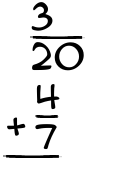What is 3/20 + 4/7?

|
This is how to add
|
|||||||||||
Step 1Of course, you can't add two fractions if the denominators (bottom numbers) don't match. To get a common denominator, multiply the denominators together. Then we fix the numerators by multiplying each one by their other term's denominator. Now you multiply 3 by 7, and get 21, then we multiply 20 by 7 and get 140. Do the same for the second term. We multiply 4 by 20, and get 80, then multiply 20 by 7 and get 140. The problem now has new fractions to add:
|
|||||||||||
Step 2Since our denominators match, we can add the numerators. 21 + 80 = 101 This yields the answer
|
|||||||||||
Step 3The last step is to reduce the fraction if we can. To find out, we try dividing it by 2... Nope. Try the next prime number, 3... Nope. Try the next prime number, 5... Nope. Try the next prime number, 7... Nope. Try the next prime number, 11... Nope. Try the next prime number, 13... Nope. Try the next prime number, 17... Nope. Try the next prime number, 19... Nope. Try the next prime number, 23... Nope. Try the next prime number, 29... Nope. Try the next prime number, 31... Nope. Try the next prime number, 37... Nope. Try the next prime number, 41... Nope. Try the next prime number, 43... Nope. Try the next prime number, 47... Nope. Try the next prime number, 53... Nope. Try the next prime number, 59... Nope. Try the next prime number, 61... Nope. Try the next prime number, 67... Nope. Try the next prime number, 71... Nope. Try the next prime number, 73... Nope. Try the next prime number, 79... Nope. Try the next prime number, 83... Nope. Try the next prime number, 89... Nope. Try the next prime number, 97... Nope. Try the next prime number, 101... Nope. Try the next prime number, 103... No good. 103 is larger than 101. So we're done reducing. Congratulations! Here's your final answer to 3/20 + 4/7
|